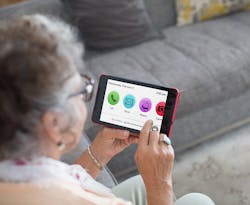Prospero Health’s Tech-Facilitated Breakthrough in Care-Managing Seniors with Chronic Illnesses
With the COVID-19 pandemic changing just about everything in terms of the ways in which healthcare is delivered in the United States, it’s no surprise that the home healthcare sector has been affected, like every other sector.
Among the organizations that has been innovating out of necessity these days has been Prospero Health, a Boston-based home health care company (with operational headquarters in Memphis) that provides compassionate care and support for frail elderly patients living with serious health conditions. Prospero’s multi-disciplinary care teams of doctors, nurses and social workers are specially trained to address complex medical needs, providing face-to-face and virtual telemedicine care in the home at scheduled appointments and anytime unexpected needs arise. Prospero serves patient communities in Connecticut, Georgia, Illinois, Missouri, New Jersey, New York, North Carolina and Philadelphia.
The leaders at Prospero Health recently partnered with the leaders at the Orange, California-based GrandPad, a firm that has developed the first purpose-built tablet for people over 75, to improve access to care for vulnerable seniors during the COVID-19 crisis. The GrandPad tablet comes ready to use out of the box and features a secure private family network and premium U.S.-based customer service.
The COVID-19 risk to elderly and immuno-suppressed patients has isolated many in their homes, making it harder for clinicians and caregivers to attend to their medical and emotional well-being. From the potential for missed medications and falls to the risk of anxiety and confusion, these patients require even greater vigilance during this global crisis. Prior to this partnership, more than 80 percent of Prospero patients did not have access to a mobile device with video chat capabilities. Utilizing GrandPads addresses that barrier to access and allows Prospero care providers to continue visual observations that enable better identification of symptoms and behaviors than with traditional telephone interactions.
Prospero Health’s president, Dave Moen, M.D., has practiced emergency medicine for 20 years, and has also practiced community-based medicine on teams taking care of geriatric patients. He actively participates in the organization’s interdisciplinary team meetings and takes call and cares for after-hours patients, in order to support the physicians. The Minneapolis-based Dr. Moen spoke recently with Healthcare Innovation Editor-in-Chief Mark Hagland to discuss the advances in care management that he and his colleagues have recently been involved in. Below are excerpts from that interview.
Tell me a bit about Prospero Health, and the context of these recent and current innovations?
Prospero is a company funded by [the Minneapolis-based] Optum, to serve underserved patients. Our focus is providing an extra layer of support for people with serious illness in the community. Palliative care physicians run our teams, so our patients have two or more chronic conditions or a recent hospitalization or skilled nursing facility stay, and thus are in a high-risk group for things like readmissions or emergency department visits. We’re available 24/7. We have teams of physicians, nurse practitioners, and social workers, who work together to manage populations in specific communities. So the care management spans in-person, telephonic, and now video-based, chronic care management. Initially, the intake was all in-person.
How many patients are you currently caring for?
About 2,000. We started in New York City and on Long Island, and now are in New Jersey and Connecticut. And now we’re also in Chicago, St. Louis, Atlanta, Charlotte, and are heading into Alabama and Philadelphia.
Tell me about the physicians who work for Prospero?
We’re not designed to replace primary care physicians; the vast majority of our patients have PCPs. Our physicians, who are involved in the care management, practice in palliative care and geriatrics. We currently have 120 clinicians altogether, and are growing very rapidly, so we hold training sessions every two weeks and typically train 20-30 new clinicians at a time.
You subcontract with health plans, correct?
Yes, that’s right. UnitedHealthcare is our largest Medicare Advantage plan we’re serving, and we’ve served others as well.
So you are primarily care-managing Medicare Advantage plan members living with two or more chronic illnesses?
Yes, that’s correct.
So, tell me how this current innovation came about?
Adding virtual care management into the home was on our road map, and we had been vetting some technologies, and chose GrandPad as a partner, primarily because of its usability for our population. They generally don’t have Wi-Fi and don’t have smartphones. So we needed a device that was LTE-capable, secure with encrypted communications, and extremely usable for people with vision and hearing deficits, and with dry fingers, which can make use difficult. And it’s cellular-enabled, so we can attach to a cellular network.
When did you go live?
In mid-April. And we now have 246 GrandPads in use in patients’ homes [as of the end of April].
Ultimately, how many patients will be using GrandPads?
In the first phase, we’re going to be launching 900 GrandPads.
What kind of communication is involved in initiating a session?
Sessions can be initiated through the GrandPad ringing like a phone, or by a patient pushing a button with a logo that goes into our call center 24/7. Patients are scheduled. So, for example, our team calls and says, we’d like to do a video visit at 10 AM on Wednesday, so there’s a pre-visit planning that occurs. That has been typical for in-person visits. And we’ve done 3,600 telephonic visits since COVID started. And now we’re seeing how the video capability advances our capability to do more. So we’re rapidly learning that video works very well for us.
What elements are involved in a typical video visit?
We have some patients who were ours prior to COVID, whom we can no longer see in person. So that would involve a typical evaluation of the patient’s overall well-being. In initial visits, we do functional assessment. We see the patient stand, have them tell us what they can do, but with video, we can actually see. Many elders, sometimes they underestimate the degree of impairment they have; that’s certainly human nature. So we’ll say, let’s see how you feel standing; take some steps, etc. And we’d be asking Mrs. Smith what types of activities she does during the day; can she get to her mailbox? Can she get to her kitchen? It just helps us confirm things with our own eyes.
How have the clinicians found it to use?
Well, if you haven’t noticed, clinicians are not rapid adopters of technology. And initially, it was, gee, I don’t know if this is going to work. But what we did was that we involved them in selecting patients. And when we got their heads around what it was we were doing, they gave us a list of patients they felt were good candidates.
What would be the defining factor in determining which patients/plan members would be appropriate candidates?
Among the elements involved are things like cognitive status, access to a caregiver. Is there a caregiver who can be of assistance? And degree of social isolation—that’s a very high risk factor and a driver of unnecessary hospitalization and emergency department use. If they don’t have a caregiver and we think they’re at risk for social isolation, that would move them up to being more of a candidate, because the technology would benefit that person; whereas if they have a cognitive impairment, we would want to know that they have a caregiver to help. Interestingly, when we got through the filter, we found that a pretty large percentage of patients would benefit from this. What is happening is that our clinicians are increasingly seeing that this adds to their capability. So they’ve become champions, and so they’re submitting more and more names.
Have there been any particular challenges in this process?
I think the initial challenge was the provider skepticism; some who had not been involved in technology implementation were a bit intimidated. That said, those of us who had done a lot of this knew that that would be a temporary dynamic. The pace of doing this was a challenge; we did this very rapidly, so it required a dedicated team working daily to really make sure that when we launched, it was a good experience for our patients and providers; we didn’t want a misstep out of the chute.
How have patients responded?
They’ve been responding great, as have their caregivers. They’ve been blown away by how much of a difference it makes that the caregiver can see the clinician. The video piece adds to the experience, for sure. So our patients are sensing that, and providers, too, are sensing the importance of that, and are beginning to see how much they can translate onto video.
And so for safety’s sake, you’ll be initiating a lot more via video than in person going forward, correct?
Correct. And also, in rural areas, we know that people suffer from lack of certain types of services, especially subspecialty services. On our roadmap is our ability to conference in specialists and primary care physicians, and allowing them to co-manage. We already do that a lot on the telephone. Adding video, I think, will have the same effect. And it’s nice to be able to offer that to our partnering health systems, that we can facilitate that type of interaction. This population has the challenge of no device and no Wi-Fi, so we’re reaching a niche population that’s difficult to reach. Our patients still are seeking curative treatments, and seeing specialists. This is not an end-of-life model; this is people with serious illness who are seeing specialists and other physicians.
Are a majority of the patients frail elderly?
Yes. Most have difficulty accessing care in a clinic, because of their frailty. And there are great examples of how well this has worked for patients. For example, recently, we had a patient with a pretty bad wound that we could evaluate through video, and could follow it via video; and we were able to help home health with their doing some wound care, and with teaching the patient’s caregiver how to do wound dressing. That would be pretty hard to do over the phone. With video, they actually felt more comfortable that we could do this via video. Wounds can be pretty difficult to evaluate or manage by phone, but the video fidelity is phenomenal; and we have several examples of wounds that we’ve managed.


